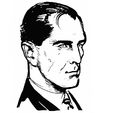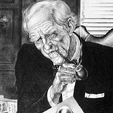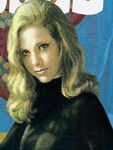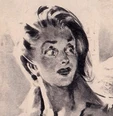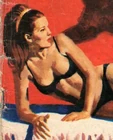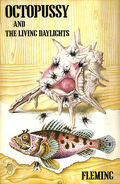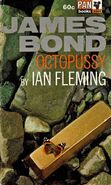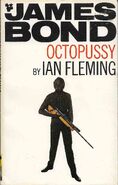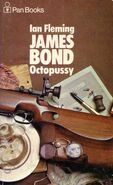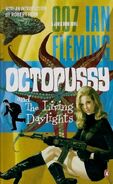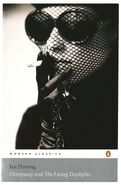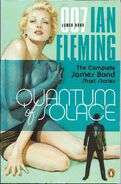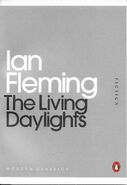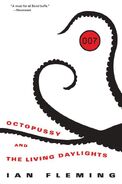m (→"Octopussy") |
Tag: Source edit |
||
| (71 intermediate revisions by 19 users not shown) | |||
| Line 1: | Line 1: | ||
| + | {{Literary}} |
||
{{Octopussy}} |
{{Octopussy}} |
||
{{The Living Daylights}} |
{{The Living Daylights}} |
||
| + | {{Infobox book |
||
| − | {{Bondbook |
||
|image = Octopussy & The Living Daylights (First Edition).jpg |
|image = Octopussy & The Living Daylights (First Edition).jpg |
||
| − | |caption = |
+ | |caption = Above: First edition cover |
| ⚫ | |||
| ⚫ | |||
|author = [[Ian Fleming]] |
|author = [[Ian Fleming]] |
||
| + | |illustrator = |
||
| − | |publisher = Glidrose Productions |
||
| ⚫ | |||
| − | |hardbackUK = 1966 |
||
| + | |country = United Kingdom |
||
| − | |hardbackUS = 1966 |
||
| + | |language = En-UK |
||
| − | |paperbackUK = 1967 |
||
| + | |series = [[:Category:Ian Fleming books|Fleming continuity]] |
||
| − | |paperbackUS = 1967 |
||
| + | |genre = Spy fiction, Action, Adventure |
||
| ⚫ | |||
| + | |publisher = [[Jonathan Cape]] |
||
| ⚫ | |||
| + | |published = {{Book Releases|UK= 23rd June [[007 franchise timeline#1966|1966]]}} |
||
| + | |pages = 94 pp <small>(first edition, hardback)</small> |
||
|preceded = [[The Man with the Golden Gun (novel)|The Man with the Golden Gun]] |
|preceded = [[The Man with the Golden Gun (novel)|The Man with the Golden Gun]] |
||
|followed = [[Colonel Sun]] |
|followed = [[Colonel Sun]] |
||
| Line 22: | Line 27: | ||
Initially, the book contained only two short stories: (i) The final James Bond short story to be published, "Octopussy" (with agent 007 in a minor role), which was first serialized in the March and April 1966 issues of ''Playboy'' magazine, some two years after Ian Fleming's death; and (ii) "The Living Daylights", considered by critics to be the best James Bond short story, which was first published in the 1962 magazine supplement to ''The Times'' newspaper (the story also appeared under the title "Berlin Escape", in the June 1962 issue of ''Argosy'' magazine). |
Initially, the book contained only two short stories: (i) The final James Bond short story to be published, "Octopussy" (with agent 007 in a minor role), which was first serialized in the March and April 1966 issues of ''Playboy'' magazine, some two years after Ian Fleming's death; and (ii) "The Living Daylights", considered by critics to be the best James Bond short story, which was first published in the 1962 magazine supplement to ''The Times'' newspaper (the story also appeared under the title "Berlin Escape", in the June 1962 issue of ''Argosy'' magazine). |
||
| − | When the first paperback edition of the collection was published in 1967, it was expanded with a third short story, "The Property of a Lady" which Fleming wrote, in 1963, for inclusion in ''The Ivory Hammer'', the annual publication of Sotheby's auction house. In the second edition, the collection's title was shortened to ''Octopussy''; most paperback reprints of the 1970s and 1980s used the abbreviated title. The third edition of the collection appeared in 2002, expanded with a fourth short story, "007 in New York". Originally titled "Reflections in a Carey Cadillac", it was however first published under the name "Agent 007 in New York" in the ''New York Herald Tribune'' in October 1963. In 1964 it was retitled simply "007 in New York" when published in the American edition of ''Thrilling Cities''. The short story was written as a consolation to readers in [[New York|New York City]] due to Fleming's grim opinion of the city. The story was not published in Britain until the late 1990s. |
+ | When the first paperback edition of the collection was published in 1967, it was expanded with a third short story, "The Property of a Lady", which Fleming wrote, in 1963, for inclusion in ''The Ivory Hammer'', the annual publication of Sotheby's auction house. In the second edition, the collection's title was shortened to ''Octopussy''; most paperback reprints of the 1970s and 1980s used the abbreviated title. The third edition of the collection appeared in 2002, expanded with a fourth short story, "007 in New York". Originally titled "Reflections in a Carey Cadillac", it was however first published under the name "Agent 007 in New York" in the ''New York Herald Tribune'' in October 1963. In 1964 it was retitled simply "007 in New York" when published in the American edition of ''Thrilling Cities''. The short story was written as a consolation to readers in [[New York|New York City]] due to Fleming's grim opinion of the city. The story was not published in Britain until the late 1990s. |
Editions of the collection published since the mid-1990s have used the original full title, ''Octopussy and the Living Daylights''. |
Editions of the collection published since the mid-1990s have used the original full title, ''Octopussy and the Living Daylights''. |
||
| − | It is not known for certain whether any of these stories were ever actually earmarked by Ian Fleming for his never-completed collection, though it is likely "The Living Daylights", at the very least, would have been a strong contender since it (unlike the others) had already been widely published by 1964. |
+ | It is not known for certain whether any of these stories were ever actually earmarked by Ian Fleming for his never-completed collection, though it is likely "The Living Daylights", at the very least, would have been a strong contender since it (unlike the others) had already been widely published by 1964. In addition, Fleming's final novel, ''[[The Man with the Golden Gun (novel)|The Man with the Golden Gun]]'', referred to the events of "The Property of a Lady", despite the story only having had limited release prior to the novel's publication. |
| − | "Octopussy" provided the title of the eponymous [[Octopussy|1983 film]], and the background for the movie character Octopussy, the daughter of the villain in the short story; the film also used most of the plot of "The Property of a Lady". |
+ | "Octopussy" provided the title of the eponymous [[Octopussy (film)|1983 film]], and the background for the movie character Octopussy, the daughter of the villain in the short story; the film also used most of the plot of "The Property of a Lady". A character in "Octopussy" was also adapted for the 2015 film, ''[[Spectre (film)|Spectre]]''. |
| + | |||
| + | In 1987, "The Living Daylights" was closely adapted for the first act of [[Timothy Dalton]]'s eponymous first James Bond [[The Living Daylights (film)|film of the same title]]. According to some sources, such as ''The Bond Files'' by Andy Lane and Paul Simpson, ''The Property of A Lady'' was under consideration as the title of Dalton's third James Bond film to be released in 1991, but it went unfilmed; little of the original short story would have been available for use, given it having been used in the ''Octopussy'' film. As for "007 in New York", some aficionados feel that, though unfilmed, the story's spirit is in the New York City segment of the 1973 film ''[[Live and Let Die (film)|Live and Let Die]]''. A likely more direct reference, however, is the closing sequence of ''[[Quantum of Solace (film)|Quantum of Solace]]'' which depicts Bond on a mission to warn a Canadian agent that her boyfriend is an enemy, paralleling Bond's mission in "007 in New York"; in addition, the character name Solange from the short story was given to a character in the 2006 ''[[Casino Royale (film)|Casino Royale]]'' film. |
||
| + | |||
| + | Several stories within the collection have been republished in other formats. In 2008, the four stories, along with those in ''[[For Your Eyes Only (book)|For Your Eyes Only]]'', were compiled in the Penguin Classics release ''Quantum of Solace: The Complete James Bond Short Stories'', released as a tie-in with the film. Also in 2008, [[Penguin Books]] published ''Octopussy and 007 in New York'' as a promotion with ''The Times''; it uses the same cover art as the 2003 edition of the main book, but only includes the two stories. In 2011, Penguin Modern Classics paired "The Living Daylights" with "From a View to a Kill" (from ''For Your Eyes Only'') in a small compilation titled ''The Living Daylights''. |
||
==Plot overviews== |
==Plot overviews== |
||
| Line 34: | Line 43: | ||
==="Octopussy"=== |
==="Octopussy"=== |
||
| ⚫ | {{Octopussy}}Told in a similar fashion to "[[For Your Eyes Only (book)#.22Quantum of Solace.22|Quantum of Solace]]", Bond is assigned to apprehend a hero of the Second World War implicated in a murder involving a cache of Nazi gold. Agent 007 appears briefly in this story, which is told mostly in flashback and from the point of view of Major [[Dexter Smythe (Literary)|Dexter Smythe]], the villain. It tells of his story in killing a Nazi officer near the end of World War II in order to steal gold bullion which he used to pay for a life of luxury in [[World locations in James Bond#Americas|Jamaica]]. He sells the gold through Manchu-Chinese merchants for money in a market in [[Macau]]. He uses it to buy a house, Wavelets, on the North Shore. |
||
| − | {{Octopussy}} |
||
| ⚫ | Told in a similar fashion to "[[For Your Eyes Only (book)#.22Quantum of Solace.22|Quantum of Solace]]", Bond is assigned to apprehend a hero of the Second World War implicated in a murder involving a cache of Nazi gold. Agent 007 appears briefly in this story, which is told mostly in flashback and from the point of view of Major [[Dexter Smythe]], the villain. It tells of his story in killing a Nazi officer near the end of World War II in order to steal |
||
| − | + | Over 15 years later, the officer's body fell out of a glacier where Smythe had dumped it. MI6 opened an investigation, and Bond took the case as the officer was a friend who taught him to ski in his teens. Bond leaves after hearing the story and implies that the authorities will arrest Smythe in due course after he writes a report. While he considers what to do, Smythe is pricked on the torso by a poisonous scorpion fish and, on the verge of death, is pulled under the water by his pet octopus. The death is reported in the local papers as an accidental drowning, and Bond officially classifies it as such even though he suspects that had the truth been revealed that Smythe commited suicide, the latter's reputation would have been ruined. |
|
====Characters==== |
====Characters==== |
||
| − | <gallery orientation="square" spacing="small" widths="113" captionalign="center" bordercolor="#000000" hideaddbutton="true" captionposition="below" captionsize="small"> |
+ | <gallery orientation="square" spacing="small" widths="113" captionalign="center" bordercolor="#000000" hideaddbutton="true" captionposition="below" captionsize="small" navigation="true"> |
James Bond (Literary) - Profile.jpg|[[James Bond (Literary)|James Bond]]|link=James Bond (Literary) |
James Bond (Literary) - Profile.jpg|[[James Bond (Literary)|James Bond]]|link=James Bond (Literary) |
||
| − | + | Smythe.jpg|[[Dexter Smythe (Literary)|Dexter Smythe]]|link=Dexter Smythe (Literary) |
|
Generic Placeholder - Profile.jpg|[[Mary Parnell]]|link=Mary Parnell |
Generic Placeholder - Profile.jpg|[[Mary Parnell]]|link=Mary Parnell |
||
| − | Generic Placeholder - Profile.jpg|[[Hannes Oberhauser]]|link=Hannes Oberhauser |
+ | Generic Placeholder - Profile.jpg|[[Hannes Oberhauser (Literary)|Hannes Oberhauser]]|link=Hannes Oberhauser (Literary) |
| − | Generic Placeholder - Profile.jpg|[[Trudi Oberhauser]]|link=Trudi Oberhauser |
||
Generic Placeholder - Profile.jpg|[[Yat Foo]]|link=Yat Foo |
Generic Placeholder - Profile.jpg|[[Yat Foo]]|link=Yat Foo |
||
Generic Placeholder - Profile.jpg|[[Kim Foo]]|link=Kim Foo |
Generic Placeholder - Profile.jpg|[[Kim Foo]]|link=Kim Foo |
||
| Line 52: | Line 59: | ||
==="The Living Daylights"=== |
==="The Living Daylights"=== |
||
| ⚫ | {{The Living Daylights}}James Bond is on the famous Centaury Firing Range at Bisley, where he is testing a rifle with an infrared scope. The rifle he is using is an American made .308 caliber International Experimental Target rifle. A five shot magazine that should not produce any fade at five hundred yards has replaced the usual single bolt action. The Chief Range Officer is pleased with the results, as Bond is consistently getting bullseyes even in the fading light. When he is finished, Corporal Menzies comes from the Pavilion of the Gun Club and dismantles the rifle and its stand. Bond tells him to tell the armourer that it is a very fine weapon, and when the Corporal says he is finding his own way back to London, he wishes him goodnight. |
||
| ⚫ | |||
| ⚫ | James Bond is on the famous Centaury Firing Range at Bisley, where he is testing a rifle with an infrared scope. The rifle he is using is an American made .308 caliber International Experimental Target rifle. A five shot magazine that should not produce any fade at five hundred yards has replaced the usual single bolt action. The Chief Range Officer is pleased with the results, as Bond is consistently getting bullseyes even in the fading light. When he is finished, Corporal Menzies comes from the Pavilion of the Gun Club and dismantles the rifle and its stand. Bond tells him to tell the armourer that it is a very fine weapon, and when the Corporal says he is finding his own way back to London, he wishes him goodnight. |
||
| − | An unusually morose James Bond is assigned sniper duty to help a defector known as "272" escape East Berlin. Bond's duty is to prevent a top [[KGB]] assassin codenamed "[[Trigger]]" from killing 272 by eliminating the sniper. However, the assignment becomes difficult when Bond discovers that Trigger is a beautiful female cellist whom he had earlier admired. Bond, never wishing to kill anyone in cold blood, decides to instead shoot the butt of her rifle, preventing her from making the kill. The mission, while successful, is also considered a failure due to Bond's last second decision, and it ends with Bond hoping that [[M (Literary)|M]] |
+ | An unusually morose James Bond is assigned sniper duty to help a defector known as "272" escape East Berlin. Bond's duty is to prevent a top [[KGB]] assassin codenamed "[[Trigger]]" from killing 272 by eliminating the sniper. However, the assignment becomes difficult when Bond discovers that Trigger is a beautiful female cellist whom he had earlier admired. Bond, never wishing to kill anyone in cold blood, decides to instead shoot the butt of her rifle, preventing her from making the kill. The mission, while successful, is also considered a failure due to Bond's last second decision, and it ends with Bond hoping that [[M (Literary)|M]] will strip him of his 00 number for it. |
====Characters==== |
====Characters==== |
||
<gallery orientation="square" spacing="small" widths="113" captionalign="center" bordercolor="#000000" hideaddbutton="true" captionposition="below" captionsize="small"> |
<gallery orientation="square" spacing="small" widths="113" captionalign="center" bordercolor="#000000" hideaddbutton="true" captionposition="below" captionsize="small"> |
||
James Bond (Literary) - Profile.jpg|[[James Bond (Literary)|James Bond]]|link=James Bond (Literary) |
James Bond (Literary) - Profile.jpg|[[James Bond (Literary)|James Bond]]|link=James Bond (Literary) |
||
| − | M |
+ | M by George Almond - Profile.png|[[M (Literary)|M]]<br>|link=M (Literary) |
Monneypenny.jpg|[[Miss Moneypenny (Literary)|Miss Moneypenny]]|link=Miss Moneypenny (Literary) |
Monneypenny.jpg|[[Miss Moneypenny (Literary)|Miss Moneypenny]]|link=Miss Moneypenny (Literary) |
||
| − | + | Bill Tanner by Yaroslav Horak.png|[[Bill Tanner (Literary)|Bill Tanner]]<br>|link=Bill Tanner (Literary) |
|
Trigger.jpg|[[Trigger]]|link=Trigger |
Trigger.jpg|[[Trigger]]|link=Trigger |
||
Generic Placeholder - Profile.jpg|[[Paul Sender]]|link=Paul Sender |
Generic Placeholder - Profile.jpg|[[Paul Sender]]|link=Paul Sender |
||
| Line 70: | Line 76: | ||
==="The Property of a Lady"=== |
==="The Property of a Lady"=== |
||
| − | James Bond is having a very uneventful day at the Ministry of |
+ | James Bond is having a very uneventful day at the Ministry of Defence headquarters when M calls him in to his office to meet a [[Dr. Fanshawe]]. M explains that Fanshawe is an expert on antique jewelry and also an advisor to H.M. Customs and the CID on this subject. |
| − | Dr. Fanshawe now explains that H.M. Customs recently intercepted a parcel in the registered mail which contained a |
+ | Dr. Fanshawe now explains that H.M. Customs recently intercepted a parcel in the registered mail which contained a rare [[Fabergé Egg]] with a declared value of £100,000. A Home Office warrant was obtained and the package clandestinely opened. Inside was the famous Emerald Sphere by Fabérgé and papers, in Russian and French, stating the provenance of the piece. The parcel was addressed to a Miss [[Maria Freudenstein]], and according to the provenance, she has inherited the Sphere from her grandfather. |
Bond investigates Freudenstein, who is a double agent about to be paid by her Russian keepers by auctioning the Fabergé egg at Sotheby's in her name. The Russians have sent the Resident Director of the KGB in [[London]] to attend the auction and underbid for the item in order to push the price to the necessary value to pay for her services as a double agent. Bond attends the auction in hopes of spotting this man; after doing so the man is expelled from London as persona non grata. |
Bond investigates Freudenstein, who is a double agent about to be paid by her Russian keepers by auctioning the Fabergé egg at Sotheby's in her name. The Russians have sent the Resident Director of the KGB in [[London]] to attend the auction and underbid for the item in order to push the price to the necessary value to pay for her services as a double agent. Bond attends the auction in hopes of spotting this man; after doing so the man is expelled from London as persona non grata. |
||
| − | Maria Freudenstein was hired by the British Secret Service with prior knowledge that she was a double agent. She is essentially tasked with sending phony SITREPS to Washington D.C., which she copies and sends to Moscow unknowning that they are fake. Her unpleasant fate is revealed in Fleming's novel |
+ | Maria Freudenstein was hired by the British Secret Service with prior knowledge that she was a double agent. She is essentially tasked with sending phony SITREPS to Washington, D.C., which she copies and sends to Moscow unknowning that they are fake. Her unpleasant fate is revealed in Fleming's novel ''[[The Man with the Golden Gun (novel)|The Man with the Golden Gun]]'', though as it happened most readers did not get to see this story, in which she first appeared, until several years after the novel came out. |
The short story also includes [[Kenneth Snowman]] as an ally of Bond. Snowman, in reality, was a master jeweler and one of the leading experts on Carl Fabergé. "The Property of a Lady" features a number of notes on the items for auction, one of which references a book by Kenneth Snowman. |
The short story also includes [[Kenneth Snowman]] as an ally of Bond. Snowman, in reality, was a master jeweler and one of the leading experts on Carl Fabergé. "The Property of a Lady" features a number of notes on the items for auction, one of which references a book by Kenneth Snowman. |
||
| Line 83: | Line 89: | ||
<gallery orientation="square" spacing="small" widths="113" captionalign="center" bordercolor="#000000" hideaddbutton="true" captionposition="below" captionsize="small"> |
<gallery orientation="square" spacing="small" widths="113" captionalign="center" bordercolor="#000000" hideaddbutton="true" captionposition="below" captionsize="small"> |
||
James Bond (Literary) - Profile.jpg|[[James Bond (Literary)|James Bond]]|link=James Bond (Literary) |
James Bond (Literary) - Profile.jpg|[[James Bond (Literary)|James Bond]]|link=James Bond (Literary) |
||
| − | M |
+ | M by George Almond - Profile.png|[[M (Literary)|M]]<br>|link=M (Literary) |
Monneypenny.jpg|[[Miss Moneypenny (Literary)|Miss Moneypenny]]|link=Miss Moneypenny (Literary) |
Monneypenny.jpg|[[Miss Moneypenny (Literary)|Miss Moneypenny]]|link=Miss Moneypenny (Literary) |
||
Goodnight.jpg|[[Mary Goodnight (Literary)|Mary Goodnight]]|link=Mary Goodnight (Literary) |
Goodnight.jpg|[[Mary Goodnight (Literary)|Mary Goodnight]]|link=Mary Goodnight (Literary) |
||
| Line 92: | Line 98: | ||
==="007 in New York"=== |
==="007 in New York"=== |
||
| − | The story |
+ | The story "007 in New York" is an inconsequential tale in which Bond muses about [[New York|New York City]], and his favorite recipe for scrambled eggs from [[Loelia Ponsonby]]. Bond, traveling as David Barlow, is going through customs and immigration at New York's Idlewild airport. He has flown in on BAOC's Monarch flight from London and estimates that the FBI or the CIA will not detect him in the twenty-four hours he will be spending in New York. His mission is to warn a female [[Secret Intelligence Service|MI6]] employee who used to be a first class staff officer for the Secret Service, that the American authorities are getting close to finding out that she is cohabiting with a [[KGB]] agent. The agent is attached to the UN and M is sending Bond to tell her that the CIA is close to identifying her. |
====Characters==== |
====Characters==== |
||
| − | <gallery orientation="square" spacing="small" widths="113" captionalign="center" bordercolor="#000000" hideaddbutton="true" captionposition="below" captionsize="small"> |
+ | <gallery orientation="square" spacing="small" widths="113" captionalign="center" bordercolor="#000000" hideaddbutton="true" captionposition="below" captionsize="small" navigation="true"> |
James Bond (Literary) - Profile.jpg|[[James Bond (Literary)|James Bond]]|link=James Bond (Literary) |
James Bond (Literary) - Profile.jpg|[[James Bond (Literary)|James Bond]]|link=James Bond (Literary) |
||
Generic Placeholder - Profile.jpg|[[Solange (Literary)|Solange]]|link=Solange (Literary) |
Generic Placeholder - Profile.jpg|[[Solange (Literary)|Solange]]|link=Solange (Literary) |
||
| Line 104: | Line 110: | ||
==Comic strip adaptations== |
==Comic strip adaptations== |
||
[[File:Opussy.jpg|thumb]] |
[[File:Opussy.jpg|thumb]] |
||
| − | Two of Fleming's short stories were adapted as daily [[James Bond comic |
+ | Two of Fleming's short stories were adapted as daily [[James Bond comic strip]]s which were published in the British ''Daily Express'' newspaper and syndicated worldwide. |
*"The Living Daylights" ran from September 12 to November 12, 1966, adapted by Jim Lawrence and illustrated by Yaroslav Horak. |
*"The Living Daylights" ran from September 12 to November 12, 1966, adapted by Jim Lawrence and illustrated by Yaroslav Horak. |
||
| Line 114: | Line 120: | ||
<gallery> |
<gallery> |
||
Octopussy & The Living Daylights (First Edition).jpg|1st edition Jonathan Cape hardback (UK) |
Octopussy & The Living Daylights (First Edition).jpg|1st edition Jonathan Cape hardback (UK) |
||
| + | Octopussy 1967.jpg|1st Pan paperback (1967) |
||
| + | Octopussy Later Pan.jpg|British Pan paperback (1970) |
||
Octopussy & The Living Daylights (Pan 1972).jpg|British Pan paperback 10th edition (1972). |
Octopussy & The Living Daylights (Pan 1972).jpg|British Pan paperback 10th edition (1972). |
||
Octopussy & The Living Daylights (Coronet 1988).jpg|British Coronet paperback 3rd edition (1988) |
Octopussy & The Living Daylights (Coronet 1988).jpg|British Coronet paperback 3rd edition (1988) |
||
| − | Octopussy & The Living Daylights (Penguin 2003).jpg|Penguin |
+ | Octopussy & The Living Daylights (Penguin 2003).jpg|American Penguin paperback edition (2003) |
| − | Octopussy |
+ | Octopussy And The Living Daylights (Penguin Classics).jpg|Penguin Modern Classics paperback edition (2004) |
| + | Quantum Penguin.jpg|UK Penguin film tie-in omnibus with ''For Your Eyes Only'' (2008) |
||
| + | Octopussy & The Living Daylights (Penguin 2009).jpg|Penguin paperback (2009) |
||
| + | Daylights Penguin.jpg|UK Penguin 2-story edition (2011) |
||
O&TLDbook.jpg|Kindle Edition (2012) |
O&TLDbook.jpg|Kindle Edition (2012) |
||
| + | 9780099577027.jpg|British Paperback (2012) |
||
</gallery> |
</gallery> |
||
{{James Bond novels}} |
{{James Bond novels}} |
||
{{James Bond short stories}} |
{{James Bond short stories}} |
||
| − | [[Category:Ian Fleming |
+ | [[Category:Ian Fleming short story collections]] |
| + | [[Category:Books]] |
||
| + | [[Category:1960s books]] |
||
Latest revision as of 17:29, 27 February 2024
Octopussy and The Living Daylights is a collection of James Bond short stories by Ian Fleming, published posthumously in the United Kingdom and the United States by Glidrose Productions, in 1966, as a postscript to his James Bond canon.
Publication overview
Before his death, Ian Fleming reportedly had intended to compile a second book of short stories in the same vein as For Your Eyes Only. After his death, Glidrose Productions followed this plan.
Initially, the book contained only two short stories: (i) The final James Bond short story to be published, "Octopussy" (with agent 007 in a minor role), which was first serialized in the March and April 1966 issues of Playboy magazine, some two years after Ian Fleming's death; and (ii) "The Living Daylights", considered by critics to be the best James Bond short story, which was first published in the 1962 magazine supplement to The Times newspaper (the story also appeared under the title "Berlin Escape", in the June 1962 issue of Argosy magazine).
When the first paperback edition of the collection was published in 1967, it was expanded with a third short story, "The Property of a Lady", which Fleming wrote, in 1963, for inclusion in The Ivory Hammer, the annual publication of Sotheby's auction house. In the second edition, the collection's title was shortened to Octopussy; most paperback reprints of the 1970s and 1980s used the abbreviated title. The third edition of the collection appeared in 2002, expanded with a fourth short story, "007 in New York". Originally titled "Reflections in a Carey Cadillac", it was however first published under the name "Agent 007 in New York" in the New York Herald Tribune in October 1963. In 1964 it was retitled simply "007 in New York" when published in the American edition of Thrilling Cities. The short story was written as a consolation to readers in New York City due to Fleming's grim opinion of the city. The story was not published in Britain until the late 1990s.
Editions of the collection published since the mid-1990s have used the original full title, Octopussy and the Living Daylights.
It is not known for certain whether any of these stories were ever actually earmarked by Ian Fleming for his never-completed collection, though it is likely "The Living Daylights", at the very least, would have been a strong contender since it (unlike the others) had already been widely published by 1964. In addition, Fleming's final novel, The Man with the Golden Gun, referred to the events of "The Property of a Lady", despite the story only having had limited release prior to the novel's publication.
"Octopussy" provided the title of the eponymous 1983 film, and the background for the movie character Octopussy, the daughter of the villain in the short story; the film also used most of the plot of "The Property of a Lady". A character in "Octopussy" was also adapted for the 2015 film, Spectre.
In 1987, "The Living Daylights" was closely adapted for the first act of Timothy Dalton's eponymous first James Bond film of the same title. According to some sources, such as The Bond Files by Andy Lane and Paul Simpson, The Property of A Lady was under consideration as the title of Dalton's third James Bond film to be released in 1991, but it went unfilmed; little of the original short story would have been available for use, given it having been used in the Octopussy film. As for "007 in New York", some aficionados feel that, though unfilmed, the story's spirit is in the New York City segment of the 1973 film Live and Let Die. A likely more direct reference, however, is the closing sequence of Quantum of Solace which depicts Bond on a mission to warn a Canadian agent that her boyfriend is an enemy, paralleling Bond's mission in "007 in New York"; in addition, the character name Solange from the short story was given to a character in the 2006 Casino Royale film.
Several stories within the collection have been republished in other formats. In 2008, the four stories, along with those in For Your Eyes Only, were compiled in the Penguin Classics release Quantum of Solace: The Complete James Bond Short Stories, released as a tie-in with the film. Also in 2008, Penguin Books published Octopussy and 007 in New York as a promotion with The Times; it uses the same cover art as the 2003 edition of the main book, but only includes the two stories. In 2011, Penguin Modern Classics paired "The Living Daylights" with "From a View to a Kill" (from For Your Eyes Only) in a small compilation titled The Living Daylights.
Plot overviews
At the start of You Only Live Twice, Bond complains about the meaningless assignments he had undertaken since the death of his wife, Tracy, at the end of On Her Majesty's Secret Service. It has been suggested that the stories in this collection may well have taken place during this dark period of Bond's career; the mention of Mary Goodnight in "The Property of a Lady" implies that that story at least takes place after On Her Majesty's Secret Service, where the character was introduced. The same story also introduces Maria Freudenstein, who is later said to have been killed in The Man with the Golden Gun, indicating it is set before that novel at the very least.
"Octopussy"
Told in a similar fashion to "Quantum of Solace", Bond is assigned to apprehend a hero of the Second World War implicated in a murder involving a cache of Nazi gold. Agent 007 appears briefly in this story, which is told mostly in flashback and from the point of view of Major Dexter Smythe, the villain. It tells of his story in killing a Nazi officer near the end of World War II in order to steal gold bullion which he used to pay for a life of luxury in Jamaica. He sells the gold through Manchu-Chinese merchants for money in a market in Macau. He uses it to buy a house, Wavelets, on the North Shore.
Over 15 years later, the officer's body fell out of a glacier where Smythe had dumped it. MI6 opened an investigation, and Bond took the case as the officer was a friend who taught him to ski in his teens. Bond leaves after hearing the story and implies that the authorities will arrest Smythe in due course after he writes a report. While he considers what to do, Smythe is pricked on the torso by a poisonous scorpion fish and, on the verge of death, is pulled under the water by his pet octopus. The death is reported in the local papers as an accidental drowning, and Bond officially classifies it as such even though he suspects that had the truth been revealed that Smythe commited suicide, the latter's reputation would have been ruined.
Characters
"The Living Daylights"
James Bond is on the famous Centaury Firing Range at Bisley, where he is testing a rifle with an infrared scope. The rifle he is using is an American made .308 caliber International Experimental Target rifle. A five shot magazine that should not produce any fade at five hundred yards has replaced the usual single bolt action. The Chief Range Officer is pleased with the results, as Bond is consistently getting bullseyes even in the fading light. When he is finished, Corporal Menzies comes from the Pavilion of the Gun Club and dismantles the rifle and its stand. Bond tells him to tell the armourer that it is a very fine weapon, and when the Corporal says he is finding his own way back to London, he wishes him goodnight.
An unusually morose James Bond is assigned sniper duty to help a defector known as "272" escape East Berlin. Bond's duty is to prevent a top KGB assassin codenamed "Trigger" from killing 272 by eliminating the sniper. However, the assignment becomes difficult when Bond discovers that Trigger is a beautiful female cellist whom he had earlier admired. Bond, never wishing to kill anyone in cold blood, decides to instead shoot the butt of her rifle, preventing her from making the kill. The mission, while successful, is also considered a failure due to Bond's last second decision, and it ends with Bond hoping that M will strip him of his 00 number for it.
Characters
"The Property of a Lady"
James Bond is having a very uneventful day at the Ministry of Defence headquarters when M calls him in to his office to meet a Dr. Fanshawe. M explains that Fanshawe is an expert on antique jewelry and also an advisor to H.M. Customs and the CID on this subject.
Dr. Fanshawe now explains that H.M. Customs recently intercepted a parcel in the registered mail which contained a rare Fabergé Egg with a declared value of £100,000. A Home Office warrant was obtained and the package clandestinely opened. Inside was the famous Emerald Sphere by Fabérgé and papers, in Russian and French, stating the provenance of the piece. The parcel was addressed to a Miss Maria Freudenstein, and according to the provenance, she has inherited the Sphere from her grandfather.
Bond investigates Freudenstein, who is a double agent about to be paid by her Russian keepers by auctioning the Fabergé egg at Sotheby's in her name. The Russians have sent the Resident Director of the KGB in London to attend the auction and underbid for the item in order to push the price to the necessary value to pay for her services as a double agent. Bond attends the auction in hopes of spotting this man; after doing so the man is expelled from London as persona non grata.
Maria Freudenstein was hired by the British Secret Service with prior knowledge that she was a double agent. She is essentially tasked with sending phony SITREPS to Washington, D.C., which she copies and sends to Moscow unknowning that they are fake. Her unpleasant fate is revealed in Fleming's novel The Man with the Golden Gun, though as it happened most readers did not get to see this story, in which she first appeared, until several years after the novel came out.
The short story also includes Kenneth Snowman as an ally of Bond. Snowman, in reality, was a master jeweler and one of the leading experts on Carl Fabergé. "The Property of a Lady" features a number of notes on the items for auction, one of which references a book by Kenneth Snowman.
Characters
"007 in New York"
The story "007 in New York" is an inconsequential tale in which Bond muses about New York City, and his favorite recipe for scrambled eggs from Loelia Ponsonby. Bond, traveling as David Barlow, is going through customs and immigration at New York's Idlewild airport. He has flown in on BAOC's Monarch flight from London and estimates that the FBI or the CIA will not detect him in the twenty-four hours he will be spending in New York. His mission is to warn a female MI6 employee who used to be a first class staff officer for the Secret Service, that the American authorities are getting close to finding out that she is cohabiting with a KGB agent. The agent is attached to the UN and M is sending Bond to tell her that the CIA is close to identifying her.
Characters
Comic strip adaptations
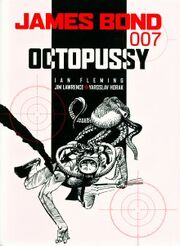
Two of Fleming's short stories were adapted as daily James Bond comic strips which were published in the British Daily Express newspaper and syndicated worldwide.
- "The Living Daylights" ran from September 12 to November 12, 1966, adapted by Jim Lawrence and illustrated by Yaroslav Horak.
- "Octopussy" ran from November 14, 1966 to May 27, 1967, again by Lawrence and Horak.
Both comic strips were reprinted by Titan Books in the early 1990s, and again in 2004. To date, "The Property of a Lady" and "007 in New York" have not been adapted as comic strips. Along with "Quantum of Solace" from For Your Eyes Only, these remain the only Ian Fleming Bond stories not yet adapted in this form.
Covers
| James Bond short stories |
|---|
| Ian Fleming For Your Eyes Only (1960): "From a View to a Kill" -- "For Your Eyes Only" -- "Quantum of Solace" -- "Risico" -- "The Hildebrand Rarity" Octopussy and The Living Daylights (1966): Raymond Benson (1997-1999) Samantha Weinberg (2006) Charlie Higson (2009) |


